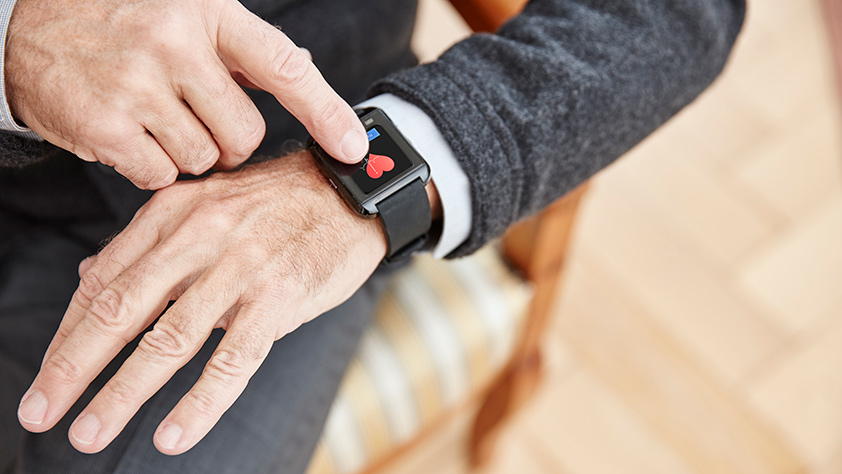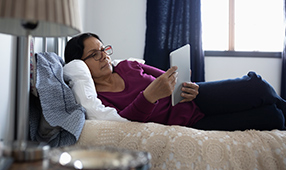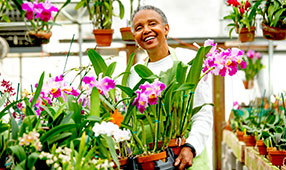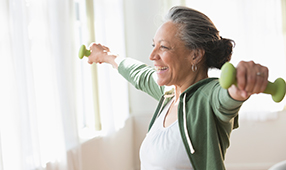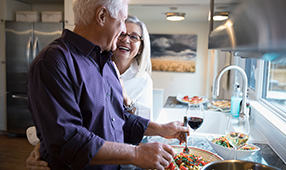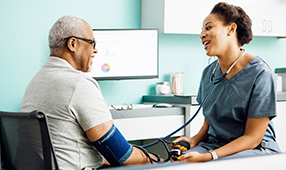The pandemic has accelerated the preference for aging in place after some 40% of COVID-related deaths occurred in long-term care facilities. Even before the pandemic, many seniors preferred staying home when given a choice between that and living in some type of institutional care facility. According to an AARP survey, three-quarters of those over 50 said they want to stay in their homes and communities as they age.
The pandemic has also boosted technologies for delivering services and virtual connections to people who are confined to home, which will continue to benefit those aging at home.
More seniors means a growing smart tech market
The U.S. Department of Health and Human Services Administration for Community Living projects that by 2040 there will be over 100 million people age 60 and older, representing about one quarter of the country’s population. Many will want to age at home and will need some kind of help with various aspects of home life. With that kind of burgeoning market, it’s no wonder the tech industry is scrambling to provide new waves of gadgets to help people stay active and independent for as long as possible.
Here are a few of the smart tech products available for seniors with varying levels of assistance needs and tech savvy.
Simple smartphones
Mobile devices, including smartphone and tablets, continue on a path to overtake desktop PCs as the primary way people access the Internet. This mobile adoption is true among seniors as well, as they understand the value of devices that can deliver email, news, weather, as well as offer apps that track blood pressure, deliver medication reminders and provide GPS location services. An overview of senior-focused smartphones—including those that are compatible with hearing aids—can be found here.
Wearables
You probably remember the “I’ve fallen and I can’t get up” commercials from a few years back. That was the nascent era of Personal Emergency Response (PERS) products. Unfortunately, many seniors refused to wear these pendants, which were not waterproof and designed strictly for a house-centric lifestyle. Newer mobile PERS (mPERS) technology is improving on the old model and includes a variety of wearable products.
The BodyGuardian Sensor is a peel-and-stick wireless monitor that performs cardiac ECG and rhythm monitoring. Data is delivered to the Preventice Care Platform and to physicians.
The idea of wearing a personal airbag might sound funny, but if you’re prone to falls or have already fractured a hip, it’s no laughing matter. Tango is a smart belt that uses fall-in-progress technology to automatically deploy an airbag around the hips to cushion impacts.
Wearable technologies are advancing constantly, and healthcare gadgets targeted at seniors can monitor or treat heart-related conditions, arthritis, diabetes, depression, COPD and asthma, as well as providing fitness and sleep data.
There are several stylish watches that offer health and emergency features, such as fall detection, medication reminders and fitness trackers. The Kanega watch is fully voice-activated and self-contained—meaning it’s not dependent on a connection to a home-based system or smartphone. You just speak to the device and it talks back to you. It can even provide simple directions on how to get back home. CarePredict® TempoTM is a wristband that monitors and records your daily patterns over time. If these patterns begin to change in ways that could indicate a health issue may be developing, an alert is sent to a family member.
GPS technology can pinpoint a person’s location with great accuracy. GPS SmartSole is an insole that can keep you connected to a family member with signs of dementia so they can be found if they wander off. The producer is launching a 4G version. Similar technology exists in watches, but people with Alzheimer’s or other types of dementia often are resistant to wearing new devices they don’t understand.
Medication monitors
Medication errors are the No. 1 cause of hospitalizations in people over 75 according to Andrew Carle, founding director of the Program in Senior Housing Administration at George Mason University. Medication alert systems tell you when to take medication and can contact a caregiver if too much time passes between scheduled dosages.
Check the ConsumersAdvocate.org list of the top 10 medical alert systems for popular options.
Food delivery services
HelloFresh, Instacart, DoorDash and a host of other food delivery services have flourished during the pandemic and are only a touch away on your smartphone or tablet. They will provide a lasting benefit for older people who don’t want to (or can’t) shop, cook or dine out.
Virtual retirement communities
Zoom, FaceTime and other ways people connect virtually are another phenomenon of the pandemic and have spurred the creation of virtual retirement communities. Seniors can age in place at home, but for a small fee they have a team standing ready to provide services, such as transportation or making medical appointments. Also, it gives them a way of connecting with people their own age.
Home automation products
Smart home technology—programmable lighting, motion detectors and video surveillance—has been around for a few decades. But the rise of wireless capabilities and a focus on renewable energy and green living has brought these technologies into the mainstream. Some home automation products are particularly suited for seniors:
- Keypad door locks and deadbolts eliminate the need to fumble with keys or turn deadbolt levers.
- Big button phone and TV remotes help those will failing eyesight.
- Voice-activated thermostats let you change the room temperature with voice commands.
- Appliance monitoring can provide reminders to turn off a coffee pot or oven and automatically lock doors.
- Video monitoring inside and outside a home can keep loved ones connected to what’s happening so they can spot issues before they become problems.
- Motion sensors can detect unusual movements, such as falls. Göz consists of a motion-detecting LED bulb, a motion-detecting bathtub drain and a companion phone app. If a person falls while in the bathtub, the system immediately empties the tub and calls for help.
- Alexa, Siri and other smart speakers have become widespread in all age groups, but they have obvious advantages for seniors. They can play music, make coffee, or call an Uber.
- Smart-home sensors take this a step further by monitoring smart devices such as lights, thermostats, speakers and even doors, and then telling these devices how to react. These sensors are compatible with smart-home systems such as Amazon Alexa, Apple HomeKit and Samsung SmartThings.
Use your member benefits to save on what you need
If you’re looking to purchase some smart gadgets, sign up for food delivery, and find other products and services that can make aging in place more comfortable, see what deals may be available to you through the NEA Discount Marketplace.
In the left-hand navigation, select “All Stores,” then browse the categories available. For example, you can look under Electronics to find retailers that might sell smartphones, wearables and home-automation technology. Or, under Food & Restaurants, look for available grocery delivery services options.
